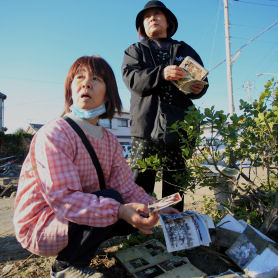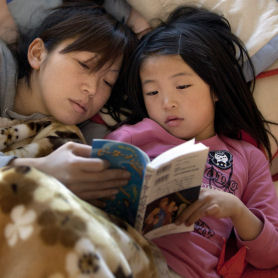Japan: charities work under threat of nuclear meltdown
As charities work to help the millions affected by Japan’s tsunami, Save the Children’s Andrew Wander writes for Channel 4 News about the challenges of making “child friendly spaces” amid the carnage.

Drive to Asahi from Tokyo in Japan, and you could almost forget that a little over a week ago, disaster stuck. The roads wind through wooded hillsides, past traditional Japanese buildings and clumps of bamboo as thick as a forearm.
Even in the town itself, there is little to suggest what happened here last Friday. True, the petrol stations are mostly closed, and the streets are eerily quiet, but it is only when you reach the seafront that the extent of the force unleashed here becomes clear.
The earthquake and tsunami have left the thick metal railings that once lined the sea-wall twisted out of shape, and across the sand-strewn road, the pavements are edged with piles of splintered wood that up until nine days ago were homes.
Asahi is one of the lucky towns on Japan’s north-eastern coast. The damage is limited to the sea-front, but even here, the misery for those caught up in this disaster is clear to see.
As I watch people sifting through the debris in the sharp spring sunshine, I realise they are digging through the mud for memories of their lives before the tsunami.
I pass a woman kneeling in the dirt, numbly flipping through a sodden photo album containing pictures of her family. She pauses for a moment on a photo of children, a reminder kids are the most vulnerable victims of any natural disaster.

That’s why Save the Children is here. The Japanese government is leading the emergency response, but we are adding our expertise in child protection, opening safe places for children to play while their parents attempt to put their lives together again.
These “child friendly spaces” are a crucially important part of our response in many emergencies. We’ve used them in disasters from the earthquake in Haiti to the floods in Queensland.
They allow children time and space to meet people their own age, to play and to talk about their experiences. In short, they give kids the chance to be kids, even in the toughest situations.
It’s not been easy to get ourselves up and running. We’ve had to deal with the ongoing situation at Fukushima nuclear plant, which has caused a great deal of anxiety amongst our staff.
At the moment the areas we’re working are safe, but we’re watching what happens there extremely closely and we’ve got evacuation plans in place in case we need them.
Meanwhile, the work we’re doing is having a tremendous impact. Despite the nuclear situation, the fuel shortages, and the freezing weather, we’re making steady progress. This week, our programme will grow, reaching more children and families caught up in this disaster.
We couldn’t do it without the help of our supporters, the people around the world who have donated to our appeal. You’ve only got to see one youngster smiling in a child-friendly space to see the difference their kindness makes.